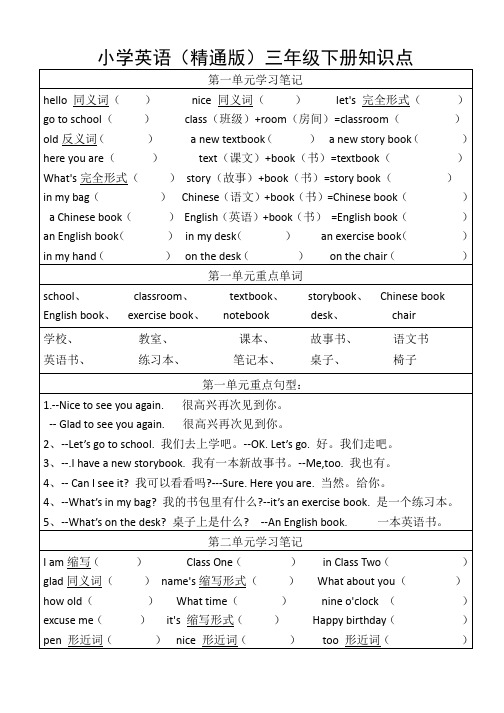缩写形式-------完全形式
- 格式:ppt
- 大小:115.50 KB
- 文档页数:11

牛津上海版小学英语五年级上册Unit 3 Mybirthday 同步测试单词拼写根据序数词的缩写形式,写出完全形式(1)1st(2)2nd(3)3rd(4)5th(5)9th(6)20th【答案】(1)first(2)second(3)third(4)fifth(5)ninth(6)twentieth【解析】(1)1st,完全形式first“第一”。
(2)2nd,完全形式second“第二”。
(3)3rd,完全形式third“第三”。
(4)5th,完全形式fifth“第五”。
(5)9th,完全形式ninth“第九”。
(6)20th,完全形式twentieth“第二十”。
单词拼写There are (7) days in a week. Sunday is the (1) day of a week.【答案】seven;first【解析】句意:一周有7天。
星期天是一周的第一天。
一周有几天,表示数量用基数词,7是seven,the+序数词,表示第几,1的序数词是first。
所以答案是seven,first。
单词拼写My classroom is on the floor. You can see classrooms on this floor. (4)【答案】fourth;four【解析】句意:我的教室在4楼。
在这层楼你能看到4个教室。
the+序数词+floor,表示第几层楼,第四是fourth,几间教室,表示数量用基数词,4是four,所以答案是fourth,four。
单词拼写I am years old. Today is my birthday. (12)【答案】twelve;twelfth【解析】句意:我12岁了。
今天是我的第12个生日。
基数词+years old,表示几岁,12是twelve,one’s +序数词+birthday,某人的第几个生日,第12是twelfth,所以答案是twelve,twelfth。

2024小学三年级外研版英语上学期期中复习题班级:_____________ 姓名:_____________【填空题】1. 按要求完成各题。
[1]isn’t(完全形式)__________ [2]yes(反义词)_____________ [3]girl(对应词)_____________ [4]I am(缩写形式)__________ [5]is(复数)____________2. 写出下列单词并正确写出它的单复数形式。
[1][2][3][4]3. 选词填空。
A. fromB. newC. HeD. WhereE. is[1]This ______ Amy.[2]_____ are you from?[3]She is a _____ student.[4]I’m _____ China.[5]_____ is a teacher.4. 写出一个与画线部分同类的词。
[1]I''d like a pear. She wants a ________.[2]I''ll take one. You''ll take ________.5. 根据句意,从括号内选择正确的单词写在横线上。
[1]—Look _________ (in/at) the beautiful bird.[2]It is an ________________ (orange/banana).[3]—Who is that girl?—_________ (She’s/He’s) my sister.[4]—__________________ (Where/How many ) cars do you have? —We have twenty.[5]—Do you like strawberries?—Yes, I _______________ (don’t/do).【单词拼写】6. 将下列字母组成单词, 并翻译。


复习(1)形容词和副词的比较级和最高级比较级:二者之间进行比较的叫比较级比较级结构••主语+谓语+形容词(副词)比较级+than+...表示“…比更…”最高级:三者或三者以上进行比较叫最高级最高级结构:主语+谓语+(the)+形容词/副词最高级+in/of短语表示“……是……中最……的(地)‘一、形容词、副词的比较级和最高级的变化规则一般单音节词,1.比较级在后面加-er,最高级在后面加-est如:small--smaller--smallest2.以不发音字母e结尾的,比较级在后面加-r,最高级在后面加-st: 如:large—larger —largest nice—nicer—nicest3.以一个元音和一个辅音结尾的重读闭音节单词.先双写末尾的辅音字母,比较级加-er,最高级加-est; big—bigger-biggest .以“辅音字母+y”结尾的单词,变y改为i,比较级加-er,最高级加-est;如:easy—easier一easiest busy—busier—busiest多音节单词和部分双音节单词的比较级是在单词前加more,最高级是在单词前加most beautiful—more beautiful—most beautiful形容词最高级前必须加定冠词the,副词最高级前加不加都行。
二、+规别变化good /well —better—bestbad/i11—worse—worstmuch/many—more—most little …less--leastfar----farther/further—farthest/furthest old—older/elder-oldest/eldest 越来越…单音节词:比较级and比较级多单节词•• more and more原形6.最高级中的of和in的区别of后面跟的是同类的人或事物,in后面跟地点或时间一、人称代词主格宾格形容词性物主代词名词性物主代词I我me我my我的mine我的you你you你your你的yours你的he他him他his他的his他的she她her 她her她的hers她的it它it它its它的its它的we我们us我们our我们的ours我们的you你们you你们your你们的yours你们的they 一them their theirs他她它们他她它们他她它们的他她它们的主格放在句首做主语,宾格放在句中,做宾语。

小学四年级牛津上册英语单词拼写专项易考题班级:_____________ 姓名:_____________【单词拼写】1. 按要求完成下列词语。
(1)am(过去式)______________(2)clean(对应词)______________(3)wasn’t(完全形式)______________2. 写出更多字母er发/ə/的单词。
3. 用A~E将下列句子排列成一段完整的对话。
4. 把无序的字母组成正确的单词并译成汉语。
1.dbe________ ___________2.gebrif________ __________3.elbat_________ ___________4.aofs__________ ___________5. neohp _________ ___________5. 用小写字母写出以下单词。
(1)TALL ___________ (2)FAT ___________(3)STRONG___________ (4)SMALL___________(5)THIN___________ (6)LONG ___________(7)HAPPY___________ (8)TAIL ___________6. 按要求写单词。
1 .非常热(中文)__________ 2. warm(对应词)__________ 3. cold(反义词)____________ 4. day (复数) ___________ 5. swim (现在分词) ____________7. 根据句意及首字母提示补全句子。
1. I like to r________ a book.2. What d________ you like to do in the morning?3. These are m________ coats.4. She does her h________ in the afternoon.8. 把下列单词译成英语。

英语缩写形式及完全形式Company Document number:WUUT-WUUY-WBBGB-BWYTT-1982GT英语缩写形式及完全形式主格八人称: I you heshe it weyou they 我是I你是you,heshe it他(她/它)全有,we是我们you你们,they是他们(她们/它们)要记真.1.主格八人称和is am are的缩写缩写形式完全形式1) I’m = Iam2) you’re =you are3) he’s= he is4) she’s= she is5) it’s= it is6) we’re= we are7)they’re = they areare和not的缩写isn’t = isnotaren’t = are not3.主格八人称和will的缩写缩写形式完全形式1) I’ll= I will2) you’ll= you will3) he’ll= he will4) she’ll= she will5) it’ll= it will6) we’ll = wewill7) they’ll =they will8) won’t= will not4.主格八人称和have has的缩写缩写形式完全形式1)I’ve got= I have got(我有)2)you’ve got=you have got (你有)3)he’s got=he has got (他有)4)she’s got=she has got (她有)5)it’s got =it has got(它有)6)we’ve got=we have got (我们有)7)they’ve got=they have got(他们有)8)haven’t = have not9)hasn’t =has not5.其它的缩写what’s= what iswho’s= who iswhere’s=where iswhere’re=where aredon’t=do notdoesn’t=does notcan’t= can notthat’s= that islet’s=let usmy name’s = my name isI’d=Iwould/should/had You’d=you would/should/had We'd=Wew ould/should/had 5.过去时态的一些缩写wasn’t= was notweren’t=were not。
小学英语讲义be动词的用法一、简缩形式的变法1、简缩形式的变法:把倒数第二个字母,通常是元音字母变成' 但are除外,are要把a打成' 。
Eg:I am=I’m he is=he's they are=they'reshe is=she’s we are=we’re it is=it’s2、简缩形式和完全形式的汉语意思相同。
3、把完全形式变成简缩形式时,一定要注意第一个字母的大小变化。
Eg:What is =What's4、记住一个特殊变化;let's =let us 让我们(不要把' 变成i)5、记住:this is 没有简缩形式 this's(错误)6、否定的简写形式:is not=isn’t are not=aren’t 如: I’m a boy.You’re a student.He’s a student.Let’s go to school. 让我们去学校。
What’s your name. 你叫什么名字。
The cat isn’t white. 这只猫不是白色的。
They aren’t students. 他们不是学生。
相应练习一、写出下列完全形式的简缩形式。
1、she is=2、we are=3、they are=4、who is=5、 play football. 让我们踢足球。
6、 my friend. 他是我的朋友。
7、 his name. 他叫什么名字。
8、she a teacher.她不是老师。
二、be动词的用法1、be动词包括am,is,are三个词。
2、Am、is、are这三个词一般在一般现在时中出现,我们可以将其用法归纳如下:am、is用于主语表单数概念的句中(主语是you除外),如:I am a student. 我是个学生。
Is your mother a doctor?你的妈妈是医生吗?Today is Tuesday. 今天是星期二。
一、单元教学内容简析:本单元教学内容以“我的教室”为中心,从教师对学生的指令语祈使句引入,主要围绕名词的复数和There be句型等相关内容展开,重点学习数词,名词复数构成及There be的相关句型的运用。
学生在经过了前三个单元的学习后,已有了一些基本的英语习惯,并能较为熟练的运用。
通过本单元的学习,可以进一步加深对英语这门语言在生活中的整体感知。
同时,学习一些新的知识点。
为此,教师可从说、唱、做、游戏等学生较为熟悉的活动入手,采用温故知新,以旧引新的教学手段,让学生通过体验、实践、参与、合作与交流的学习方式,最终达到综合能力的全面提高。
二、单元教学要求:A、知识目标:1、理解祈使句的用法,会听句子执行命令。
2、掌握数词的用法,以及关于教室内物品名称的单词:teacher‟s desk ,chair,rubber, and so on.B、技能目标:掌握本单元的基本句型:“There is/are ……”,会用这些句子来描述自己所看到的情况。
C、情感目标:培养学生的口语交际能力以及同学之间的合作精神。
三、单元教学重、难点1. 熟练掌握四会词汇和重点句型。
2. 正确运用祈使句以及它的否定形式。
3. 掌握数字的拼写规则。
4. 会用There be 结构造句并且知道它与have 的区别。
5. 掌握名词的复数四、单元课时安排:共5课时第一课时学习Welcome to the unit and Listening第二课时学习Speaking第三课时学习Reading第四课时学习Grammar第五课时学习Task五、友情提示:在教学中,教师尽可能的运用直观教具,如图片,实物,体态语等,为学生创设语言情境,帮助学生正确理解生词以及句子的含义。
引导学生在交际中运用语言。
I.[Teaching content]Unit 4 Welcome to the unit and Listening.II.[Teaching aims and demands]1、学习用祈使句来发出指令并做出响应,例如:Open the windows,***.Close the door, ***.Clean the blackboard, ***.2、礼貌用语的使用,例如:Close the door, please .3、词汇:Open, door,please,close, stand up, sit down, bag, book, pencil box, clean, windows,desk, blackbord .III.[Important and difficult point]能熟练应用祈使句型。
新目标七年级(上)英语知识点总结一、先将句子分成三类:1)含有be动词(am, is, are )的句子构成肯定句:主语+be(is,am,are)+其他.否定句:主语+be(is,am,are)+not+其他.一般疑问句:Be+主语+其他?回答:肯定:Yes,主语+be. 否定:No,主语+be+not.2)含有实义动词的句子构成(如like,have,play,eat,run,need)肯定句:主语+实义动词+其他.否定句:主语+don't(一、二人称)/doesn't(第三人称单数)+动词原形+其他. 一般疑问句:Do/Does+主语+动词原形+其他?回答:肯定:Yes,主语+do/does. 否定:No,主语+don't/doesn't.3)含有情态动词的句子,如can。
(情态动词无人称和数的变化)肯定句:主语+情态动词+其他.否定句:主语+情态动词+not+其他.一般疑问句:情态动词+主语+其他?回答:肯定:Yes,主语+情态动词. 否定:No,主语+情态动词+not.二、划线提问:划线提问的实质是把原句变成特殊疑问句,所以选特殊疑问词是关键,常用的特殊疑问词有:疑问副词:When 时间状语,提问何时 When is your birthday?Where 地点状语,提问地点 Where is my backpack?Why 原因状语,提问表示原因的短语或句子 Why does Jim like English ? How 方式状语,提问程度或方式的副词或短语How do you spell “watch”?疑问代词 :Who 主语、宾语、表语,用来表示“人”的各种成分 Who has a ruler?Whom 宾语,用来提问宾语的人是“谁”Whose 定语、表语,用来提问“谁的” Whose pen is it?Which 主语、宾语、表语、定语,用来提问“哪一个/位”等。
小学英语必会的完全形式和缩写形式1. I’m = I am ( 我是)2. didn’t = did not ( 过去式---不要)3. what’s = what is (什么是)4. it’s = it is ( 它是)5. she’s = she is ( 她是)6. who’s = who is ( 是谁)7. that’s = that is ( 那是)8. let’s = let us (让我们) 9. he’s = he is (他是) 10. they’re = they are (他们是) 11. aren’t = are not ( 复数---不是) 12. where’s = where is ( 哪里是)13. don’t = do not ( 不要) 14. doesn’t = does not (三单人称---不要)15. can’t = can not ( 不能) 16. couldn’t = could not ( 过去式---不能)17. wasn’t = was not (过去式单数---不是) 18. you’re = you are ( 你是)19. weren’t = were not (过去式复数---不是) 20. isn’t = is not ( 单数---不是) 21. I’d like = I would like ( 我想。
我喜欢。
)小学英语必会的完全形式和缩写形式1. I’m = I am ( 我是)2. didn’t = did not ( 过去式---不要)3. what’s = what is (什么是)4. it’s = it is ( 它是)5. she’s = she is ( 她是)6. who’s = who is ( 是谁)7. that’s = that is ( 那是)8. let’s = let us (让我们) 9. he’s = he is (他是) 10. they’re = they are (他们是) 11. aren’t = are not ( 复数---不是) 12. where’s = where is ( 哪里是)13. don’t = do not ( 不要) 14. doesn’t = does not (三单人称---不要)15. can’t = can not ( 不能) 16. couldn’t = could not ( 过去式---不能)17. wasn’t = was not (过去式单数---不是) 18. you’re = you are ( 你是)19. weren’t = were not (过去式复数---不是) 20. isn’t = is not ( 单数---不是) 21. I’d like = I would like ( 我想。